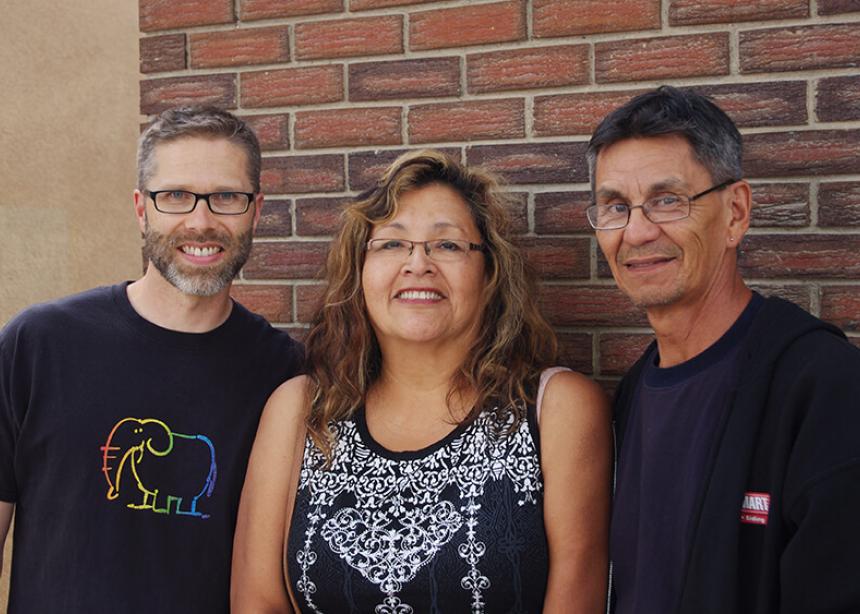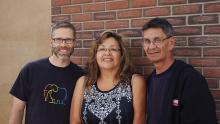Marcel French’s tanned complexion and dark hair easily identify him as Anishinabe. Which is why he likes to drop a Low German word or expression into his speech and watch the surprise on his listeners’ faces. “When I go to Jake’s Restaurant in Steinbach, I always ask for Gnurpel,” he says with a chuckle.
Marcel French jokes about the fact that he’s an indigenous man who’s fluent in Low German, but the circumstances that brought it about are anything but humorous. French was one of tens of thousands of First Nations, Métis and Inuit children taken from their birth families in the 1960s, ‘70s and early ‘80s and put into the care of non-indigenous families as part of the Canadian government’s strategy of assimilation. It’s commonly referred to as the “sixties scoop.”
Some children went to loving homes while others were abused or mistreated by their adoptive or foster families. But nearly all, it seems, were disconnected from their families, language, culture and identities as indigenous people. In an indicting report published in 1985, the late Justice Edwin Kimelman referred to the actions of the child welfare system during this period as “cultural genocide”— a term that’s been used more recently to describe the residential schools system. This summer Manitoba became the first province to publicly apologize to survivors of the sixties scoop for “this historical injustice.”
French was a baby when his parents were diagnosed with tuberculosis and sent to a sanatorium in the town of Ninette, Man. He was placed with a Mennonite foster family in Altona who had as many as 26 children in their care at a time.
“We were sleeping eight or nine to a room,” he says. In the summertime, French and his siblings were put to work hoeing beets in the hot sun from seven in the morning until eight at night. Sometimes their parents would then take them into town for half an hour of swimming before the pool closed. It was a small consolation. By then the heat of the day had passed and all the other kids had gone home to their dinners.
French remembers his foster parents as very strict. “You didn’t question them.” He says they would strap him and his siblings with a belt or yardstick for offences as small as being late for dinner or accidentally muddying a pair of new shoes. In the small Mennonite town, it seemed to French that he and his siblings were blamed for everything that went wrong.
French ran away from home when he was 17. “I always said to myself, if I ever have kids, my kids aren’t ever going to put up with what I went through,” he says.
Delvina Kejick was placed in a Mennonite foster home near Kilarney in the 1960s, after her birth parents were sent to the Ninette sanatorium. Her foster parents were much more alert to the day-to-day racism that affected indigenous children living in small Mennonite towns than French’s were. When visiting missionaries singled out Kejick and her siblings as examples of brown-skinned people in need of salvation, her mother put a stop to it. Kejick also witnessed her mother confront school teachers who laid unfair blame on indigenous students.
Still, it wasn’t until Kejick got to know other indigenous people as an adult that she began to fully accept herself as a Cree woman. Thirteen years ago Kejick started hosting weekly community powwows at her home in Brandon. The events feature drumming and dancing, feasts and spiritual teachings.
“We sing ceremony songs or prayer songs for somebody who’s passed away,” she says. “It’s definitely comparable to church. Its our spiritual place. It’s our community place.” With her own people Kejick feels a depth of acceptance she never experienced in a Christian church. And there’s a spiritual expressiveness in her own language—which she’s learned as an adult—that she doesn’t find in English. “I now see that whether you call him God or the Creator, that he delights in me coming to him as he created me—as a Cree person,” she says.
Steve Heinrichs, director of indigenous relations for Mennonite Church Canada, believes Mennonites have yet to fully reckon with their role in the sixties scoop. Even though many families had good intentions, most didn’t understand “the complexities of cross-cultural adoption,” he says. “And I really don’t think we are all that different today from that 1960s Mennonite community that was blind to its white normativity,” he says. “Despite all the struggle we’re having in our church to talk about sexuality, I think it’s harder for us to talk about race or whiteness.”
Kejick feels her foster parents did the best they could with the knowledge they had. Still, she recognizes the harm done by the government’s attempts to strip indigenous people of their culture. “It just made our journey in life harder—being placed in non-aboriginal homes,” she says. “There is so much that happens in the realm of your own people and language.”
A starlight tour
“My brother and I were coming home from church. Our church was in the middle of town and we lived in the south of town. The chief of police stopped us and said, ‘Get in.’ We thought, ‘Well, it’s the middle of winter; he’s going to give us a ride home.’ So we got in. We had nothing to be scared of. But then he turned around and we went down Centre Avenue and kept going. We said, ‘Where are we going?’ We were only dressed to go from home to church and back. He drove us four or five miles west of Altona into the middle of nowhere and said, ‘Get out.’ My parents were strict. We had to be in by a certain time. If we weren’t in by that time, we got it. Here we were, five miles out of town in the middle of winter, walking. We couldn’t get rides because there was no one out there at that time of night. So we walked. When we got home, we told my parents. They said, ‘Why would he do that?’ They didn’t believe us.” —Marcel French
‘These are your people’
“When I was eight years old, I was in our town and I saw this native man from a distance, and I ran and hid. My parents had to look for me. I really couldn’t verbalize why I ran and hid like I did. They saw that fear, but they also recognized it wasn’t just fear; there was some sort of shame to it. My mom said, ‘It’s not good for her to be scared of her own people.’ And so after that they took more deliberate action to get together with another family who had native foster kids. And they took us out to Sioux Valley during a powwow and we sat and we watched. I remember my mom saying, ‘I don’t understand it, but it’s beautiful. These are your people.’ I remember having this sense of how I looked like everybody else. I never really said it out loud. There was just stuff starting to happen within me that I recognized.” —Delvina Kejick
See a response to these stories in the Readers Write letters from January 4, 2016 issue.



Add new comment
Canadian Mennonite invites comments and encourages constructive discussion about our content. Actual full names (first and last) are required. Comments are moderated and may be edited. They will not appear online until approved and will be posted during business hours. Some comments may be reproduced in print.